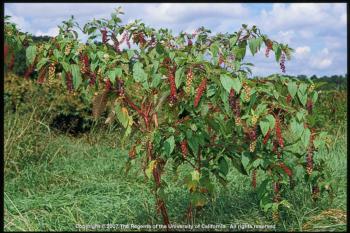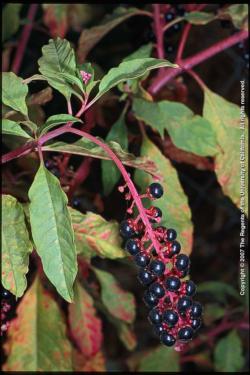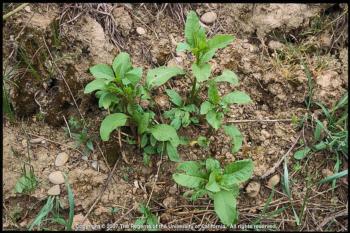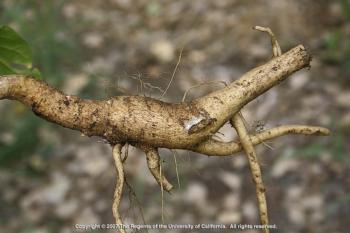Common Pokeweed
By Scott Oneto, Farm Advisor, University of California Cooperative Extension
This time of year, I often get asked, “what is that huge weed growing in my yard with dark black berries and big green leaves.” Pokeweed!

American pokeweed (Phytolacca americana) is a robust, non-woody shrub that is weedy throughout much of California. Native to the eastern United States from Maine to Wisconsin, south to Texas, Mexico and Florida, pokeweed now occurs throughout much of North America. It is sometimes cultivated as an ornamental or garden vegetable, however more often it’s considered an undesirable weed. Pokeweed is found in riparian areas, oak woodlands, forest edges, fence rows, forest openings, pastures, under power lines, disturbed areas, vineyards, orchards, cultivated fields, parks, and ornamental landscapes.
Also called poke salad, poke sallet, pokeberry, inkberry, American nightshade, American spinach, scoke, and pigeonberry, the plant’s uses are as diverse as its names. Pokeweed has an extensive history for being used as a food, medicine, herb, dye for clothing, ink for writing, colorant for wines, and much more. Although used for food, extreme caution should be used, as the entire plant is poisonous causing a variety of symptoms, including death in rare cases.
IDENTIFICATION

BIOLOGY
Reproduction is by seed and a single plant can produce 1,500 to 7,000 seeds annually. The seeds are large, lens-shaped, glossy, and black. Seeds can remain viable in the soil for up to 50 years. Pokeweed berries serve as an important food source for many species of birds, including Robins, Cedar-waxwings, Warblers, pigeons, and many others. New populations of pokeweed are spread primarily by birds. Seeds germinate in mid spring through early summer when soils are warm and moist. Germination is followed by rapid growth.

Pokeweed’s above-ground growth dies back after the first Fall frost, leaving large skeletons that breakdown over the winter. In the Spring, plants resprout from a large fleshy taproot.
IMPACT

HISTORICAL SIGNIFICANCE
American pokeweed has a long history in the United States. A wide variety of chemicals have been isolated from pokeweed that have medicinal properties and Native Americans have used the plant in herbal remedies for centuries. During the Civil War, soldiers wrote letters using the ink from American pokeweed berries, and the pigment is still used occasionally to dye fabrics. Pokeweed has also been a favorite staple of country cuisine since colonial times, when tender young shoots were boiled and eaten as “poke salad”. Resembling canned spinach, “Poke salad” or “Poke sallet” was once available commercially and still inspires “Poke” festivals across portions of the east coast and the Deep South. American singer-songwriter and guitarist, Tony Joe White is best known for his 1969 hit song “Polk Salad Annie”, that was performed by Elvis Presley and Tom Jones. The shoots proved so popular to the first European explorers to the New World, it is documented that early Europeans took the sprouts back to Europe where they were equally enjoyed.
While Pokeweed has been used in folk medicine to treat numerous health problems and is still used in many herbal remedies today, medical research has not shown whether pokeweed is indeed effective in treating many of these ailments. Recently a protein in the plant “pokeweed antiviral protein” shows promise in being used in treating cancer, herpes, human immunodeficiency virus (HIV), and for conferring broad spectrum disease resistance in agricultural crops.
Researches have also been examining pokeweed for other uses. The dark red dye made from pokeweed is currently being tested to coat fiber based photovoltaic solar cells. The dye acts as an absorber, helping the cells tiny fibers trap more sunlight to convert into power. This fiber cell technology can produce as much as twice the power that current flat-cell technology can produce, and the dye made from pokeweed is much less expensive than a polymer dye.
What’s in a name. The scientific name Phytolacca americana comes from the Greek word phyton meaning plant and lacca meaning crimson lake in reference to the deep reddish-purple fruits. The second term, americana is in obvious reference to this plant being native to America. The common name poke is derived from puccoon, pocan or poughkone (from an Algonquin Indian name for this plant). Berries were once used to make ink, hence the sometimes-used common name of inkberry. An additional common name is poke sallet, local term meaning salad.
MANAGEMENT
Prevention - Pokeweed is spread by seed and new occurrences are often where birds frequent. Monitoring for new seedlings in areas below tree canopies, along fence rows, and below other perches, often provides the best strategy for surveillance and early detection.
Mechanical - Hand pulling is effective on small plants. Once plants are established and develop an extensive root system, hand removal is difficult. Digging out established plants with a shovel is effective, but often difficult in summer when soils are dry. Cutting well below the root crown prevents regrowth. Cultivation can also be effective on new seedlings in raised beds or other areas where tilling can be used.
Cultural Control - Grazing is not considered an effective control option and animals should not be encouraged or allowed to consume large quantities of pokeweed. Seeds and foliage contain numerous saponins and oxalates and can be fatally toxic to livestock when ingested.
Biological Control - There are no biological control agents currently available for the management of pokeweed.
Chemical Control - The effectiveness of herbicides applied to the foliage depends on three factors—timing, achieving good coverage, and concentration.
Timing. Foliar application of herbicides to pokeweed is most effective after leaves are fully developed and when the plant is actively growing. This period normally is from April into July or August, when soil moisture remains adequate.
Don’t apply herbicides before plants begin their spring growth or in late fall when plants are stressed. Although not typically a problem, dust can cover plants growing near roadsides. Herbicides, particularly glyphosate, can readily attach to dust or soil particles, thus reducing their effectiveness.
Coverage. You can apply herbicides as a foliar spray using one of two methods. The first is spray-to-wet, where all leaves and stems should glisten following an application. Coverage, however, should not be to the point of runoff.
The other method is a low-volume foliar application called drizzle. This technique uses a higher concentration of herbicide, but you spray it at a lower volume. This method is advantageous in dense shrubbery or where access is limited. To achieve proper coverage, spray the herbicide uniformly over the entire canopy in a “drizzle” pattern, using a spray gun.
Concentration. For spray-to-wet applications, products containing at least 41% glyphosate as the active ingredient can provide good to excellent control of pokeweed when applied at 3.75 ounces of product per gallon of water (3% of the total solution). Some products available for use in the home landscape with this concentration of active ingredient are Roundup Pro Concentrate®, FarmWorks Grass & Weed Killer 41% Glyphosate Concentrate, RM43 Total Vegetation Control, Compare-N-Save Grass & Weed Killer Concentrate, and Remuda® Full Strength. Glyphosate products that have a lower concentration of active ingredient, such as Roundup Weed & Grass Concentrate (18% active ingredient), will require about 6 ounces of product per gallon of water (4.7% of the total solution) for effective control.
Triclopyr is available in either amine or ester formulations, with triclopyr ester being more effective on pokeweed. Products containing a minimum of 61% active ingredient of the ester formulation can provide good to excellent control when applied at 1 to 1.25 ounces of product per gallon of water (0.75% to 1.5% of the total solution). One such product with this concentration is Brushtox Brush Killer with Triclopyr. Other ester formulations with less concentrate are also available including Crossbow. Mixing triclopyr ester with commercially available seed oils can offer better penetration. One available product is Southern Ag Methylated Seed Oil. Mix this at 1.25 ounces of product per gallon of herbicide solution (1% of the total solution). Triclopyr is also available in the amine formulation. Products available include Bayer Bio Advanced Brush Killer Plus, Ortho Brush-B-Gon Poison Ivy and Poison Oak & Brush Killer, and Monterey Brush & Vine Control.
The drizzle application method is good in situations of dense planting, or when it is difficult to cover an entire area due to topography. Glyphosate formulated into a product with 41% active ingredient can provide good to excellent control of pokeweed when applied at 13 ounces of product per gallon of water (10% of the total solution).
You also can apply triclopyr ester using a drizzle application. Products containing 61% active ingredient should be applied using 6.5 ounces of product (5% of the total solution) and 25 ounces of seed oil (20% of the total solution) per gallon of water.
Remember that although the drizzle technique uses a higher concentration of herbicide, you are applying it at a lower volume. One gallon of mixed herbicide solution should adequately treat one-half acre of densely populated pokeweed.
The best time to apply either herbicide is during active plant growth. Seedlings can be treated in early spring through summer. Mature plants should be treated in late summer during flowering as this will draw the herbicide into the root system. Glyphosate is a non-selective herbicide that has no soil activity and triclopyr is a broadleaf selective herbicide with very limited soil activity. When air temperatures are higher than 80°F, it is better to use glyphosate or the amine formulation of triclopyr, since the ester form is subject to vaporization.
All photos from J.M. DiTomaso and E.A. Healy, Weeds of California and Other Western States, 2007. No endorsement of named products is intended, nor is criticism implied of similar products that are not mentioned.
Scott Oneto, is the Farm Advisor and County Director for the University of California Cooperative Extension Central Sierra. He can be reached at sroneto@ucanr.edu or 209-223-6834.
